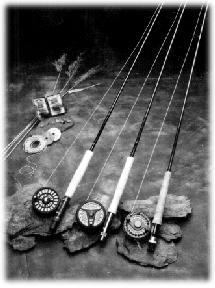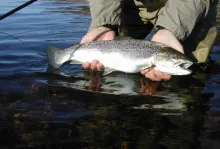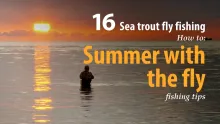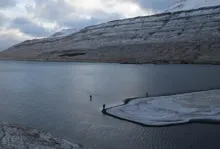Most Danes fish 7-8 wt. rods and lines. And most use a weight forward floating (WF-F) line or a shooting head. Expect that fairly long casts under difficult (that's mostly windy) conditions can save a day. All salt water flyfishing is done wading, and both waders and warm clothes for almost all seasons are essential.
Please refer to the new and updated page on gear for coastal sea trout.
7-8 wt. is ideal
Most Danes fish 7-8 wt. rods and lines. And most use a weight forward floating (WF-F) line or a shooting head. Expect that fairly long casts under difficult (that's mostly windy) conditions can save a day. All salt water flyfishing is done wading, and both waders and warm clothes for almost all seasons are essential.
Lately a lot of fishers have changed to lighter tackle. Taking into consideration the average size of the fish caught and the size of the flies used, that can be a good idea. i have fished a 5 wt. with a shooting head these last seasons with great luck.

More on tacklein the Fish Better section
Tackle must be robust
Also be aware that the tackle has to tolerate some bashing. Salt water, sand, sprays and general abuse is the order of the day, so leave the rose wood seated cane rod at home and bring a no-nonsense carbon rod.
A fast rod can be an advantage
Also a stiffer and faster rod will work often better than a slow delicate and soft rod. Distance can be important, while presentation rarely is.
Line is mostly floating Weight Forward
The preferred line is a floating weight forward, but sink tips can come in handy, especially in the extreme of seasons -- summer and winter -- where fish will often stay deep. The hard nails use shooting heads which offer the best combination of casting distance and line flexibility.
Short leaders will work
Leaders are normally short -- one rod length or a bit more -- and can be quite heavy. Tippets are the same: 2X to 0X are often used. Only in the calmest autumn water will thin long tippets be crucial.
Salt can kill a reel
The reel can be almost any reel that will hold the described line and 50-100 yards of backing. Breaks are rarely necessary, but can be comfortable. The most important trait of the reel is that it tolerates salt. Salt is a killer on anything mechanic. Buy salt resistant (or tolerant) products and rinse and grease all mechanics often.
- Log in to post comments








I live in the UK and
I live in the UK and my wife and I own several excellent ATH reels (Rio Orbigo's and Galletin's) but the shop where we bought them no longer services them and we now wish to do this ourselves but we cannot find a web site or address for ATH. Can you help us to procure the tools and materials we require to be able to service our reels ourselves please?